March 10 to 30, 2025: Political controversies, campaign trail dominate media coverage
Third Report on the TV Coverage of the Elections 2025
METHODOLOGY: CMFR reviewed and analyzed the primetime news programs of four broadcast stations: GMA-7’s 24 Oras and 24 Oras Weekend; ABS-CBN’s TV Patrol and TV Patrol Weekend; TV5’s Frontline Pilipinas and Frontline Pilipinas Weekend; and NewsWatch Plus’ NewsWatch Now (no weekend program) for three weeks, from March 10 to March 30, 2025.
ALSO SEE:
- Kicking off the campaign period: Admin-backed senatorial candidates receive more TV news mileage
- Feb 17 to March 9, 2025: Airtime for election news dips
A SURGE of political controversies roiled the three weeks of campaign from March 10 to 30, 2025, along with the arrest of former President Rodrigo Duterte, who was served a warrant by the International Criminal Court (ICC) on March 11. On the same day, Duterte was flown to the Hague in the Netherlands, where he has been held in custody for the trial over the alleged crimes against humanity committed during his administration’s bloody war on drugs. Duterte’s arrest dominated news coverage, headlined and sustained through the week with significant media coverage. The arrest raised other thematic concerns which gained media mileage, spilling over to campaign reports of some senatorial candidates, In particular, news about the reactions of Imee Marcos and Ronald dela Rosa bolstered news coverage of their candidacies.
Mainstream media continued the practice of consolidating campaign rallies into single news reports during this period. These segments gave equal airtime to both well-known and lesser-known candidates, often highlighting campaign promises delivered during sorties. While this approach ensures exposure for all candidates, it can also disperse overall impact, overwhelming audiences with disconnected notes picked up from various campaigns including unrelated policy positions in a single summary of the overall campaign.
Grouping the news based on theme or policy focus frames the information given to the public about the different candidates and their thinking. For example, on March 11, TV Patrol aired a story focused on candidates’ platforms concerning the protection of women’s rights — providing a framework with which to compare different positions, drawing voters into thinking more about the positions taken by candidates on issues and matters that directly affect their lives.
The period also marked the official start of the local campaign season on March 28. However, CMFR did not note any increase in media attention to local candidates. Reports mainly featured campaign activities in Metro Manila and a few highly urbanized cities, with little to no coverage of provincial races or the role of local political dynasties and their various strongholds. The coverage lacked the comprehensive view that keeps the audience in touch with the rest of the country, giving them a chance to look into local strongholds that make up national politics and its impact on public life. It may be difficult for Manila-based media to sustain a national scope; but the press from the capital region should develop approaches that will deepen the understanding of politics beyond their precincts.
Number of Election-Related Reports
A total of 139 election-related news reports aired across major TV news programs during this period. The distribution was as follows: TV Patrol and TV Patrol Weekend, 46 reports; 24 Oras and 24 Oras Weekend, 40 reports; Frontline Pilipinas and Frontline Pilipinas Weekend, 18 reports; NewsWatch Now, 16 reports.
Most reports focused on senatorial candidates (59 stories), followed by general election coverage (39 reports). There were 17 reports specifically on local campaigns, and only 2 reports featured party-list groups.
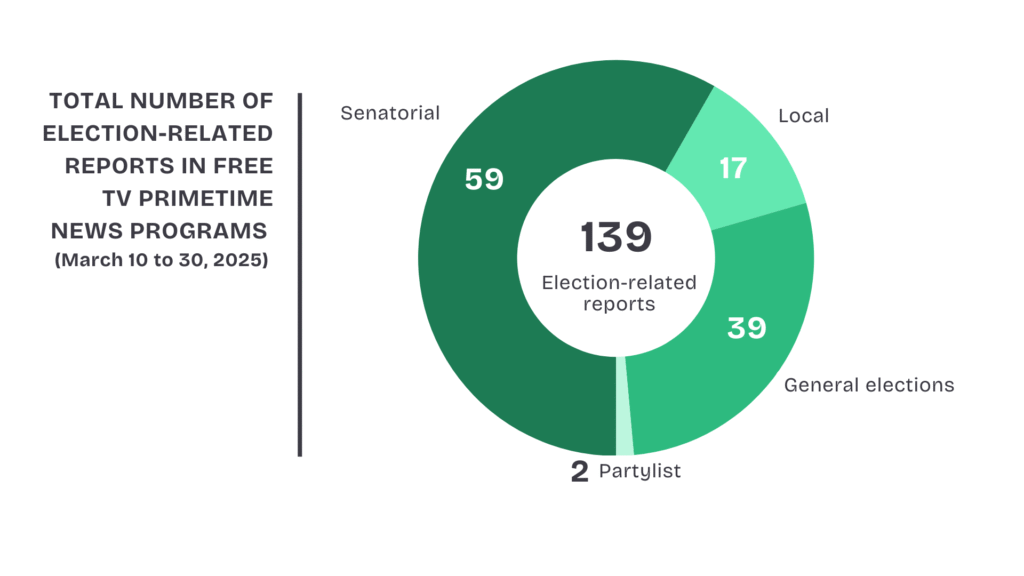
Themes
Political controversy was the dominant theme in the coverage; with 41 reports, largely centered on the ICC’s arrest order for Duterte. This included reactions from senatorial candidates, such as Dela Rosa, himself named as a suspect in the ICC case, and Imee Marcos, who made headlines for withdrawing from her brother President Ferdinand Marcos Jr.’s senatorial slate, Alyansa ng Para sa Bagong Pilipinas, in protest.
Events on the campaign trail dominated as a subject of news accounts, with 40 reports.
Other key themes included: Election conduct, 20 reports; Election law, 14 reports; Electoral-related violence (ERV), 9 reports; Horse Race and Surveys, 7.
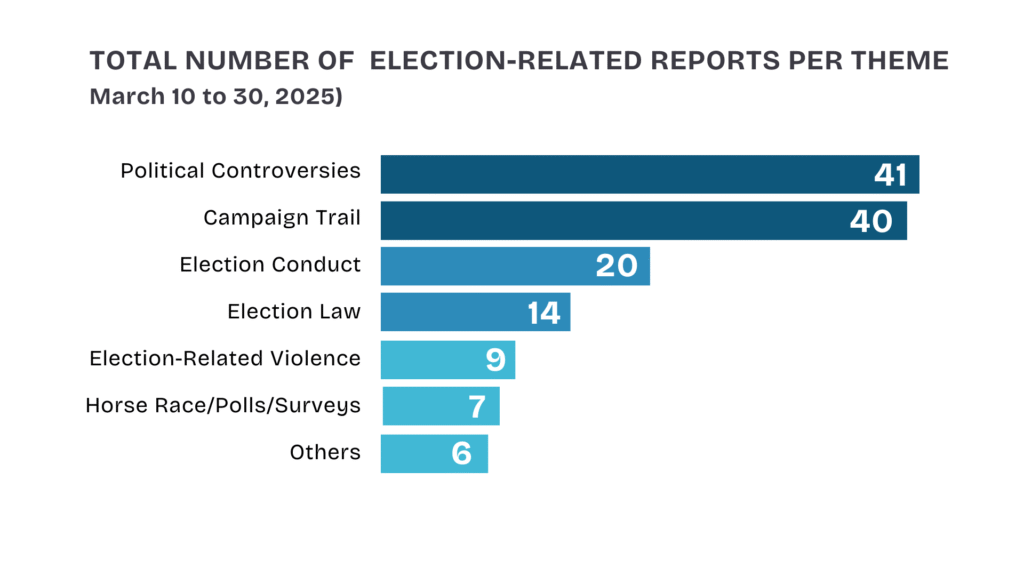
Most Covered, Most Quoted
The top three most covered candidates during this period were: Aquino with 34 reports; Bong Go with 31; and Kiko Pangilinan, 28. But their coverage were presented in grouped reports, lacking the highlight that a single report carries.
In contrast, Dela Rosa (27 reports) and Marcos (26 reports) received dedicated coverage. Dela Rosa was prominently featured due to his implication in the ICC case. Marcos boosted her media mileage with her outspoken stance on Duterte’s arrest, her role in the Senate hearing questioning the legality of the arrest, and her withdrawal from the ruling coalition’s slate all gaining news attention.
Nine members of the Alyansa were among the most covered.
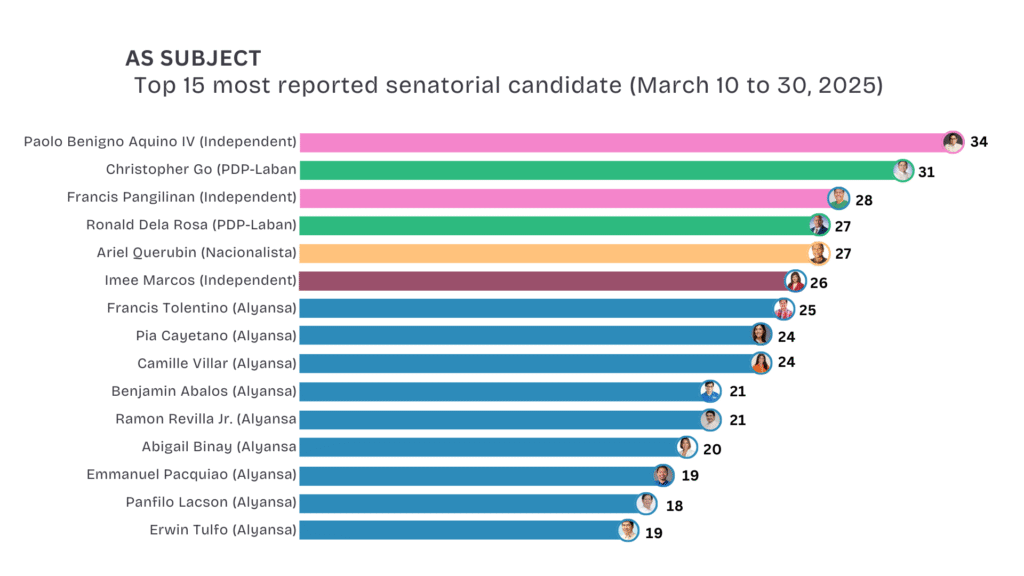
In terms of direct quotes in news reports: Imee Marcos was the most quoted with 16 reports; Aquino was quoted in 12 reports; Dela Rosa in 9 reports.
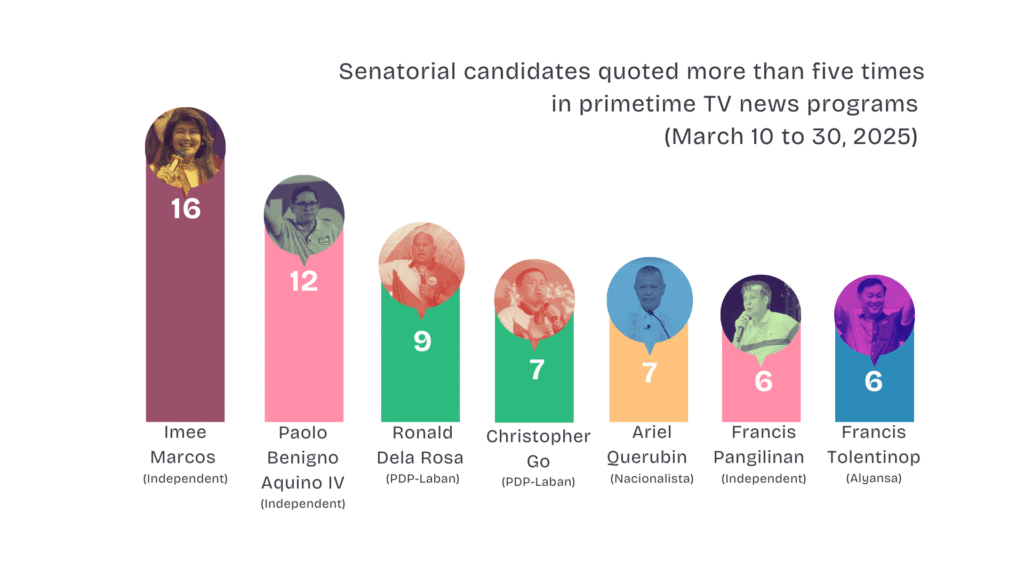
With a few weeks left before the elections, the media’s coverage should dedicate airtime to the discussion of issues, engaging candidates to speak more on their positions on various problems. The over-reliance on consolidated reports has limited the focus on individual platforms of politicians. Meanwhile, the minimal attention given to local races and party-list groups leave out the voices that these represent in the news.
Moving forward, media organizations should consider diversifying their electoral coverage by delving deeper into policy issues, increasing focus on local situations, and highlighting candidates’ important platforms, ensuring that election reporting helps voters make informed, meaningful choices that go beyond name recall and spectacle.
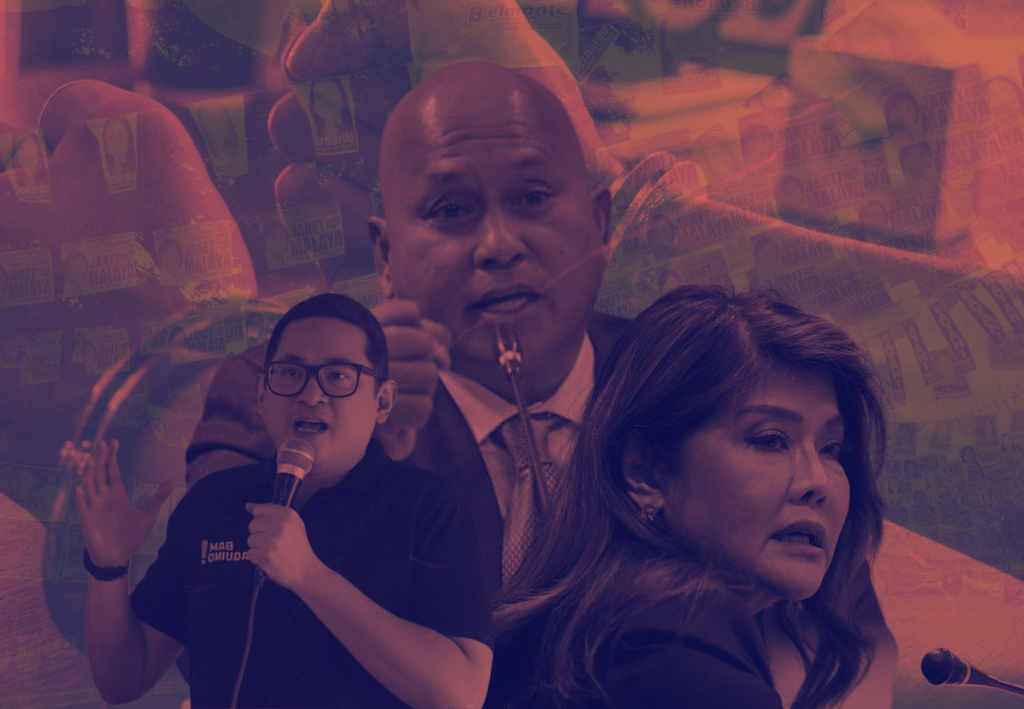
Leave a Reply